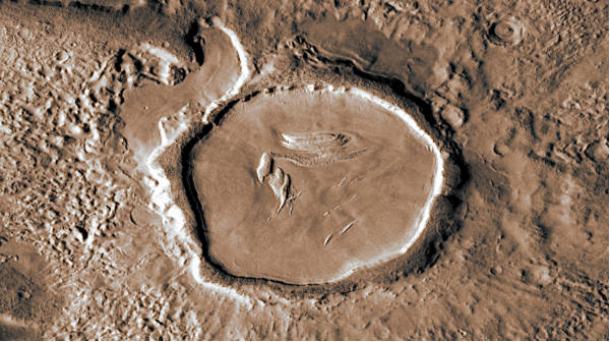🔴 Website 👉 https://u-s-news.com/
Telegram 👉 https://t.me/usnewscom_channel
A Chinese rover that has been exploring Mars’ northern hemisphere for more than three years has found evidence to suggest that this region was once covered by a gigantic ocean. This huge body of water could have spread out over as much as one-third of the planet’s surface, Chinese scientists based in Hong Kong claim, in a newly published study that boosts the long-held theory that Mars was once a wet planet that could conceivably have supported life.
A Giant Crater with a Giant Sea
In May 2021 the Chinese rover Zhurong, carried by its orbital lander Tianwan-1, landed on Mars in the southern Utopia Planitia region, which is located in the planet’s northern lowlands. This area is part of one of the solar system’s largest impact craters, which has a diameter exceeding 2,000 miles (3,200 kilometers). This would have given it the required topography to have maintained an ocean 3.7 billion years ago, when the study authors believe this sea existed.
A combination of geochemical analysis of rock samples and a visual examination of the Utopia region’s features, plus supplementary data obtained via satellite, “unveiled features consistent with the existence of a nearshore zone in southern Utopia,” the study authors wrote in a new paper published in Scientific Reports. “Different types of water-related geomorphological features were separated by specific topographic contours, suggesting different types of marine environments.”
Mars crater in southwest Utopia Planititia. (NASA/Public Domain).
The most interesting evidence discovered included “pitted cones,” as well as “pancake-like ejecta, polygonal troughs, and etched flows,” the researchers wrote, concluding that “the Utopia Planitia region on Mars exhibits water-related features on its surface.”
The pitted cones they reference are common on the plains of the northern lowlands of Mars. It is thought they may have been formed by mud volcanoes, which develop in areas where there had once been significant quantities of water or ice. Additionally, the polygonal troughs they mention could have been created by alternating cycles of freezing and thawing water, caused by the existence of subsurface water and ice.
At some point this huge ocean froze, creating a long and distinctive coastline, before disappearing approximately 3.4 billion years ago, the Chinese scientists estimate.
Lead study author Bo Wu, an associate professor in the Land Surveying and Geo-Informatics Department at Hong Kong Polytechnic University, emphasized in an interview with the APF published by Phys.org that his team “does not claim that our findings definitively prove that there was an ocean on Mars.”
Zhurong rover and Tianwan-1 lander shortly after landing in southern Utopia Planitia in 2021. (NASA/JPL/Public Domain).
Nevertheless, he insists that what they’ve discovered is absolutely consistent with that idea, and notes that the rover Zhurong had been exploring an area of Mars where other researchers have claimed to have observed evidence of surface water in the distant past.
Is the Evidence Conclusive? One Scientist Says No
Interestingly, one scientist who has examined evidence for the existence of an ocean on Mars and found it persuasive is actually skeptical of the Chinese scientists’ claims.
That is Benjamin Cardenas, an assistant professor of geosciences at Penn State University who has been studying Mars for many years. While admitting the data produced by the Chinese researchers is sound and could have been related to oceanic activity, he remains unconvinced.
Among other objections, he believes Bo Wu and his team did not factor in the effects of the persistently strong Martian wind, which has been whipping up sediment and blasting it against rocks and wearing them down for the last three or four billion years.
“We tend to think of Mars of being not very active, like the moon, but it is active!” Cardenas told the AFP.
What this means, he said, is that erosion would have so much impact on the planet’s surface features that most signs of an ancient ocean wouldn’t have survived. He noted that modeling research had suggested that “even the slow Martian erosion rates” would have wiped out any signs of a shoreline over the course of a few billion years.
Bo Wu acknowledged that wind erosion is a complicating issue. But he argued that meteor impacts on the planet would have “excavated underground rock and sediment to the surface from time to time,” explaining some of the signs that seem to indicate extensive wind erosion.
Where There is Water, There Could Be Life
The idea that Mars was once covered with water is a persistent one, despite the lack of any definitive proof. What is known is that Mars lost most of its atmosphere over time because of its weak magnetic field, and without an atmosphere to provide surface pressure any liquid water on the surface would have turned to vapor and disappeared long ago. Subsurface ice does still exist on Mars even today, however, and is close enough to the surface to be detected in some photographs.
Region of Utopia Planitia where buried ice is close to the surface, photographed by NASA rover Sojourner. (NASA/JPL/Public Domain).
Even if Mars’ ocean evaporated completely billions of years ago, if it was ever there it raises the possibility that life evolved on Mars just as it did on earth.
“Most scientists think life on Earth sprung up either under the ocean where hot gases and minerals from the subsurface came to the seafloor, or very close to the interface of water and air, in little tidal pools,” Cardenas explained. “So, evidence for an ocean makes the planet appear more hospitable.”
Top image: China’s Martian rover Zhurong with its orbital lander, Tianwan-1, on Mars. Source: Chinese News Service/CC BY 3.0.
By Nathan Falde



